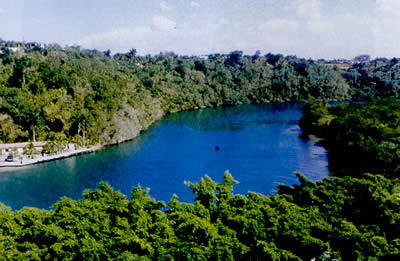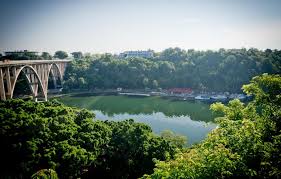The city of Matanzas, among its nicknames, that of the City of Rivers, by the three river currents that cross its urban geography, that the coming October 12 will be 324 years of foundation.
They are Yumurí, San Juan and Canímar, each with its own characteristics for visual benefit of residents and visitors of the town, located 100 kilometers east of Havana.
The Canímar River, with more than 12 kilometers navigable, of its 19 in total, is the largest and most powerful of which flow into the bay of Matanzas, and along this ribbon offers the attraction of a river valley.
It is born in the region known as Santa Ana, receives waters of numerous tributaries that come from the localities of Juan Gualberto Gómez, Cidra, Caoba, Limones and Santa Ana.
Among the most important, according to scholars in this area, are Yaité or Yaití, known as Big Lemons; The one of La Palma, the one of Cidra and the one of Guamacaro also named Moreto or Morato.
Its orientation is towards the north and the mouth is located in the eastern band of the rada yumurina, with a maximum width of 100 meters and six deep, and is divided into Canímar Arriba and Canímar Abajo.
Navigating it is to have companions to a large number of birds of a wide diversity, combined species permanently resident in the region, with others that in winter or summer migrate in search of favorable climates.
The slopes of the canyon reach almost vertical slopes of up to 90 meters of height, and the vegetation in the coastal perimeter is represented by shrubs denominated xeromorfos that cover millenary rocks.
The territory has a splendid nature, and to stop illegal operations, especially smuggling, the Spanish colonial authorities built in 1720 the fort El Morrillo, west of the mouth, building that currently houses a museum.
No less interesting is the fact that in the environment it is possible to find about 90 species of birds, among them the Tocororo, national bird of Cuba; 23 reptiles and 18 terrestrial mammals including the smallest bat in the world.
CANIMAR, LEGENDS AND ABORIGINES
Canímar was the seat of Cuban aborigines from before our era until the sixteenth century, and an ancient legend refers to the loves of a beautiful Indian and the cacique Canimao.
The area is considered by specialists as one of the richest from the archaeological point of view of Matanzas, a province populated thousands of years ago by native communities at different levels of development. In Canímar, historical texts stand out, 31 Aboriginal settlements are reported and there is ample evidence that corresponds to mesolithic type communities.
Two funerary sites are: Canímar Abajo y Cristales; As well as two lithic workshops: Playita and Canímar I, and some caves with pictographs like the one named Centella.
The river provided drinking water, while the sea provided numerous natural resources as sources of food and raw material, hence the almost invariable proximity of these archaeological sites in that region.
Experts note that the natives fed the flesh of marine molluscs in the coastal domain areas, and with species of the supralittoral area, while land molluscs were also part of the diet.
In 1964 it was discovered in Canímar the site agroalfarero long considered the most western of the island, where was located a ceramics moderately finished with handles that copied animal forms.
Another of the typical elements of these groups, according to speleological texts, was the burén, a kind of clay tray that served for the cooking of the cassava, a kind of bread with cassava; Some with printing or molding basket weaving, probably mats.
In 1978, for its part, the speleological group Carlos de la Torre exhumed a human burial in an atypical position, and since that date in the region of Morrillo have been found more than 100 skeletons of indigenous.
As specialists stand out the interested people or simply of transit can find and to enjoy in the Canímar river, the nature and the history.
Nuestras provincias Cubanas: Historia del Matancero “Rio Canimar”.
La ciudad de Matanzas, ostenta entre sus sobrenombres, el de la Ciudad de los Ríos, por las tres corrientes fluviales que atraviesan su geografía urbana, que el venidero 12 de octubre cumplirá 324 años de fundada.
Son el Yumurí, el San Juan y el Canímar, cada uno con sus características propias para beneplácito visual de moradores y visitantes de la villa, situada a 100 kilómetros al este de La Habana.
El río Canímar, con más de 12 kilómetros navegables, de sus 19 en total, es el mayor y más caudaloso de los que desembocan en la bahía de Matanzas, y a lo largo de esta cinta se ofrece el atractivo de un valle de origen fluvial.
Nace en la región conocida como Santa Ana, recibe aguas de numerosos afluentes los cuales proceden de las localidades de Juan Gualberto Gómez, Cidra, Caoba, Limones y Santa Ana.
Entre los más importantes, según estudiosos en esta materia, se encuentran el Yaité o Yaití, conocido como Limones Grandes; el de La Palma, el de Cidra y el de Guamacaro también nombrado Moreto o Morato.
Su orientación es hacia el norte y la desembocadura se ubica en la banda oriental de la rada yumurina, con un ancho máximo de 100 metros y seis de profundidad, y está dividido en Canímar Arriba y Canímar Abajo.
Navegar por él es tener de compañeras a gran cantidad de aves de una amplia diversidad, combinadas especies residentes de forma permanente en la región, con otras que en invierno o verano emigran en busca de climas favorables.
Las laderas del cañón alcanzan pendientes casi verticales de hasta 90 metros de altura, y la vegetación en el perímetro costero está representada por matorrales denominados xeromorfos que encubren rocas milenarias.
El territorio cuenta con una espléndida naturaleza, y para poner coto a operaciones ilegales, sobre todo de contrabando, las autoridades coloniales españolas construyeron en 1720 el fortín El Morrillo, al oeste de la desembocadura, edificación que actualmente alberga un museo.
No menos interesante es el hecho de que en el entorno es posible encontrar cerca de 90 especies de aves, entre ellas el Tocororo, ave nacional de Cuba; 23 de reptiles y 18 de mamíferos terrestres incluido el murciélago más pequeño del mundo.
CANIMAR, LEYENDAS Y ABORÍGENES
Canímar fue asiento de aborígenes cubanos desde antes de nuestra era hasta el siglo XVI, y una antigua leyenda refiere los amores de una bella india y el cacique Canimao.
La zona está considerada por especialistas como una de las más ricas desde el punto de vista arqueológico de Matanzas, provincia poblada hace milenios por comunidades nativas en distintos niveles de desarrollo. En Canímar, destacan textos históricos, se reportan 31 asentamientos aborígenes y existen amplias evidencias que corresponden a comunidades del tipo mesolítico.
Dos sitios funerarios destacan: Canímar Abajo y Cristales; así como dos talleres líticos: Playita y Canímar I, y algunas cuevas con pictografías como la nombrada Centella.
El río proveyó agua potable, mientras el mar aportó numerosos recursos naturales como fuentes de alimento y materia prima, de ahí la casi invariable cercanía de estos sitios arqueológicos en esa comarca.
Apuntes de expertos precisan que los nativos se alimentaron con la carne de los moluscos marinos en las zonas de dominio costero, y con especies propias del área supralitoral, en tanto los moluscos terrestres también formaron parte de la dieta.
En 1964 fue descubierto en Canímar el sitio agroalfarero considerado por mucho tiempo el más occidental de la isla, donde se localizó una cerámica medianamente terminada con asas que copiaban formas de animales.
Otro de los elementos típicos de estos grupos, acotan textos espeleológicos, fue el burén, especie de bandeja de barro que servía para la cocción del casabe, una especie de pan a base de yuca; algunos con la impresión o molde de tejidos de cestería, probablemente esteras.
En 1978, por su lado, el grupo espeleológico Carlos de la Torre exhumó un entierro humano en posición atípica, y desde esa fecha en la comarca del Morrillo se han encontrado más de 100 esqueletos de indígenas.
Como destacan especialistas las personas interesadas o simplemente de tránsito pueden hallar y disfrutar en el río Canímar, la naturaleza y la historia.
Agencies/Rad.Habana/Wilfredo Alayón/Extractos/ Internet Photos/Arnoldo Varona/TheCubanHistory.com
THE CUBAN HISTORY, HOLLYWOOD.










